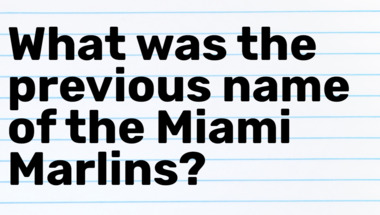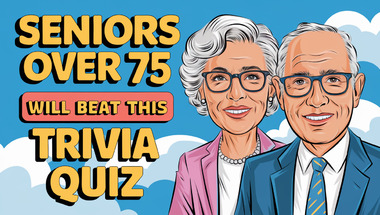

10 mixed questions

10 quite impossible questions

10 questions about food

Trivia quiz for experts

How's your trivia brain doing?

>> 10 mixed questions <<

Can you also score a solid 7/10?

10 mixed questions to have fun with

How many of them will you answer correctly?

How nerdy are you?

Please tell me your score in the comments

Post your score in the comments!

10 extremely difficult questions

Can you find the missing word?

10 mixed questions

How many of these songs do you remember?

10 Quite Difficult Questions

10 questions

How many countries flags do you know?

Please provide a new variant of this in the s..

Are you smart enough for this one?

10 fun questions

10 questions in mixed categories

Can you tell us all the words?

10 Questions For The Knowledgeable

10 mixed questions

10 questions. Are you up for the challenge?

Post your score in the comments!

10 mixed questions

Let me know your low score in the comments :)

10 mixed questions

Tell me your score after taking my quiz

10 questions

What did you score?

Do you remember all these famous songs?

10 random questions

Can you answer these 10 questions to evaluate..

Ten fun questions

10 questions to test your knowledge

10 questions

10 mixed questions for you

10 very difficult questions

How high can you score?

10 questions

How many of them will you answer correctly?

How many correct will you get?

History quiz

10 questions to test your knowledge

Post your score in the comments!

10 questions to test your knowledge

Challenge : get 6 of these right!

Goal : Score 4 out of 10

Can you reach 3 out of 10 correct answers?

10 questions

Trust us, the last 2 questions will haunt you

Trust us, the last 2 questions will haunt you

10 questions

How many correct will you get?

10 mixed up questions in a range of categorie..

This quiz will trick most people

Can you answer 6 of these 10 questions correc..

Let us see how smart you really are!

10 Quite Difficult Questions

10 questions for you

How many correct answers will you get?

You won't get close to 10/10 in this quiz

That last questions will make you stumble

10 trivia questions in mixed categories

What do you remember?

10 mixed up questions

10 questions lined up

What is the number of accurate answers you wi..

Trivia Ladder Test For Experts

10 fun questions

Did you travel enough to beat this trivia qui..

10 mixed up questions

10 questions to test your knowledge

How many correct will you get?

10 fun questions

How many of them will you get right?

Test your knowledge with 10 trivia questions

How many correct will you get?

10 songs to guess

10 questions

How many of them will you answer correctly?

We tell the actors, you tell us the show

10 questions than even a monkey can answer

10 questions shuffled into fun categories

We bet you can't tell us who sang these 10 so..

10 rather difficult questions

10 question trivia quiz

Are you up for a quiz?

10 questions of mixed topics

10 songs to guess

How many songs can you guess?

How will you do in this general knowledge qui..

Let's see how smart you really are!

How many correct will you get?

How good a home cook are you?

How much do you know?

Mixed category quiz

10 mixed questions

How many songs do you know?

10 geography-related questions

Scoring 4/10 in the target

10 questions in mixed categories

How many of them do you remember?

10 questions

10 monstrously hard questions

How many of them will you answer correctly?

10 questions to answer

How many correct answers will you get?

Let me know your score in the comments

Only members of the intellectual elite will s..

How many correct will you get?

10 geography-related questions

How do you say these words in Italian?

Let Me Know Your Score In the Comment Section

10 mixed questions

10 trivia questions in mixed categories

Trivia questions are a fun way to challenge your knowledge and learn interesting facts about the world. Let's dive deep into the stories, facts, and history behind ten intriguing trivia questions, exploring the answers and the fascinating details that surround them.
1. A pony is a young…?
At first glance, it might seem straightforward, but this question tricks many! A pony is not a young horse, as many might assume. In fact, a pony is a small breed of horse, bred specifically to be smaller in size. The young of a horse, regardless of whether it's a pony or a full-sized horse, is called a foal. Ponies are distinct from horses due to their stockier build, thicker manes, and overall shorter height (less than 14.2 hands at the withers). Famous pony breeds include the Shetland and Welsh Pony. So, next time you spot a small horse, remember—it’s not necessarily a baby, it could be a fully grown pony!
2. Washington, Adams and Jefferson were the first presidents of which country?
This question takes us back to the late 18th and early 19th centuries, a pivotal time in world history. George Washington, John Adams, and Thomas Jefferson were the first three presidents of the United States of America. Their presidencies helped shape the fledgling nation after its independence from Great Britain. Washington, as the revered leader of the American Revolution, set many of the standards for the office. Adams, a key figure in drafting the Declaration of Independence, was known for his role in building up the nation’s institutions. Jefferson, the principal author of the Declaration, expanded the country via the Louisiana Purchase. These men laid the foundations for American democracy and governance.
3. What religion is followed by both John Travolta and Tom Cruise?
The answer is Scientology. This modern religion was founded by L. Ron Hubbard in the 1950s and has gained both attention and controversy over the decades. John Travolta and Tom Cruise are two of its most famous adherents, often speaking publicly about how Scientology has impacted their lives and careers. Scientology centers around the belief that humans are immortal spiritual beings and emphasizes self-knowledge and spiritual fulfillment. Notably, the Church of Scientology has been the subject of documentaries, books, and investigations, but its celebrity followers have ensured it remains a topic of public interest.
4. What surname is often given to dishes that consist of some form of meat baked in a puff pastry?
The culinary term you’re looking for is “Wellington”. The most famous example is “Beef Wellington,” a classic dish consisting of beef tenderloin coated with pâté and duxelles (a finely chopped mushroom mixture), wrapped in puff pastry and baked. Other meats or even vegetarian fillings can be prepared “Wellington-style,” and the name always signifies that delicious, flaky, golden-brown pastry crust. The dish is believed to be named after Arthur Wellesley, the 1st Duke of Wellington, who defeated Napoleon at Waterloo; however, some food historians debate the true origin. Regardless, “Wellington” now universally means something delicious encased in pastry!
5. Acceleration is a change in what?
This question delves into the world of physics. Acceleration is defined as a change in velocity. Velocity itself is a measure of both the speed and direction of an object. Therefore, acceleration can mean an object is speeding up, slowing down, or changing direction. The unit of acceleration in the International System of Units (SI) is meters per second squared (m/s²). Famous equations like Newton’s Second Law (Force = mass x acceleration) rely on this fundamental concept. Acceleration is essential in everything from understanding car performance to the motion of celestial bodies.
6. To which part of the world are the Zulus native?
The Zulus are native to Southern Africa, specifically the region that is now part of South Africa. The Zulu nation is one of the most well-known ethnic groups on the continent. Their history is rich, marked by powerful leaders like King Shaka Zulu in the early 19th century, who united various tribes and established a formidable kingdom. The Zulu people have a strong cultural heritage, with distinctive music, dance, and beadwork. Today, South Africa’s KwaZulu-Natal province is considered the heartland of the Zulu nation.
7. Peanuts and milk chocolate combine to make what?
If you’re craving a snack, this question might make you hungry! Peanuts and milk chocolate are the main ingredients in the popular candy “Reese’s Peanut Butter Cups” in the United States, but also in other treats like “Snickers” bars, which combine peanuts, caramel, nougat, and milk chocolate. The combination of salty peanuts and sweet, creamy chocolate has delighted taste buds for decades, resulting in some of the world’s best-selling confections. Whether you prefer cups, bars, or clusters, this pairing has become a classic in the candy world.
8. Margaret River and Clare Valley are famous wine-producing regions in what country?
Both Margaret River and Clare Valley are renowned for their wines and are located in Australia. Margaret River, in Western Australia, is celebrated for its premium Cabernet Sauvignon and Chardonnay, while Clare Valley, in South Australia, is especially famous for its Riesling. The wine industry is a significant part of the Australian economy, and these regions attract wine lovers from around the globe. The unique terroir and climate of each region contribute to the distinctive flavors found in their wines.
9. In 'Treasure Island' what is the name of Long John Silver’s parrot?
This classic adventure novel by Robert Louis Stevenson introduced readers to unforgettable characters, including Long John Silver, the cunning pirate. His faithful parrot is named “Captain Flint”. The bird is famous for squawking pirate phrases like “Pieces of eight!” and has become an iconic image of pirate lore in literature, film, and popular culture. The name “Captain Flint” itself is a nod to another feared pirate in the novel’s backstory, adding an extra layer of intrigue to this memorable companion.
10. Who was the first member of the Royal Family to donate blood?
This question touches on both royal tradition and medical history. The first British royal to donate blood was King George VI, during World War II. His decision to donate blood publicly was part of a campaign to encourage British citizens to do the same during a time of great need. The act was widely publicized and helped de-stigmatize blood donation, inspiring thousands to follow suit. The involvement of the royal family in such campaigns has continued to this day, often lending crucial support to public health efforts.
Conclusion
Trivia questions like these offer more than just a quick challenge—they open doors to history, science, culture, and even culinary delights. The stories behind the answers provide a deeper appreciation for the world around us and reveal how interconnected our knowledge can be. Whether you’re playing a trivia game with friends or just expanding your horizons, each question is a gateway to fascinating facts and stories.